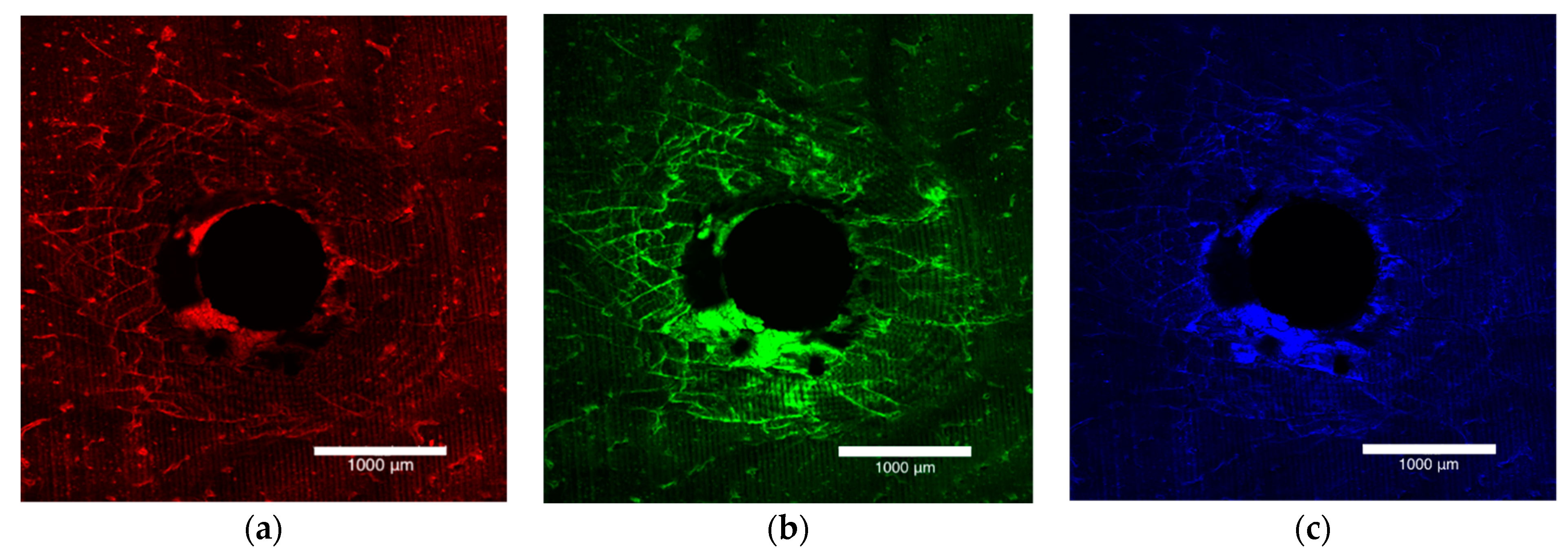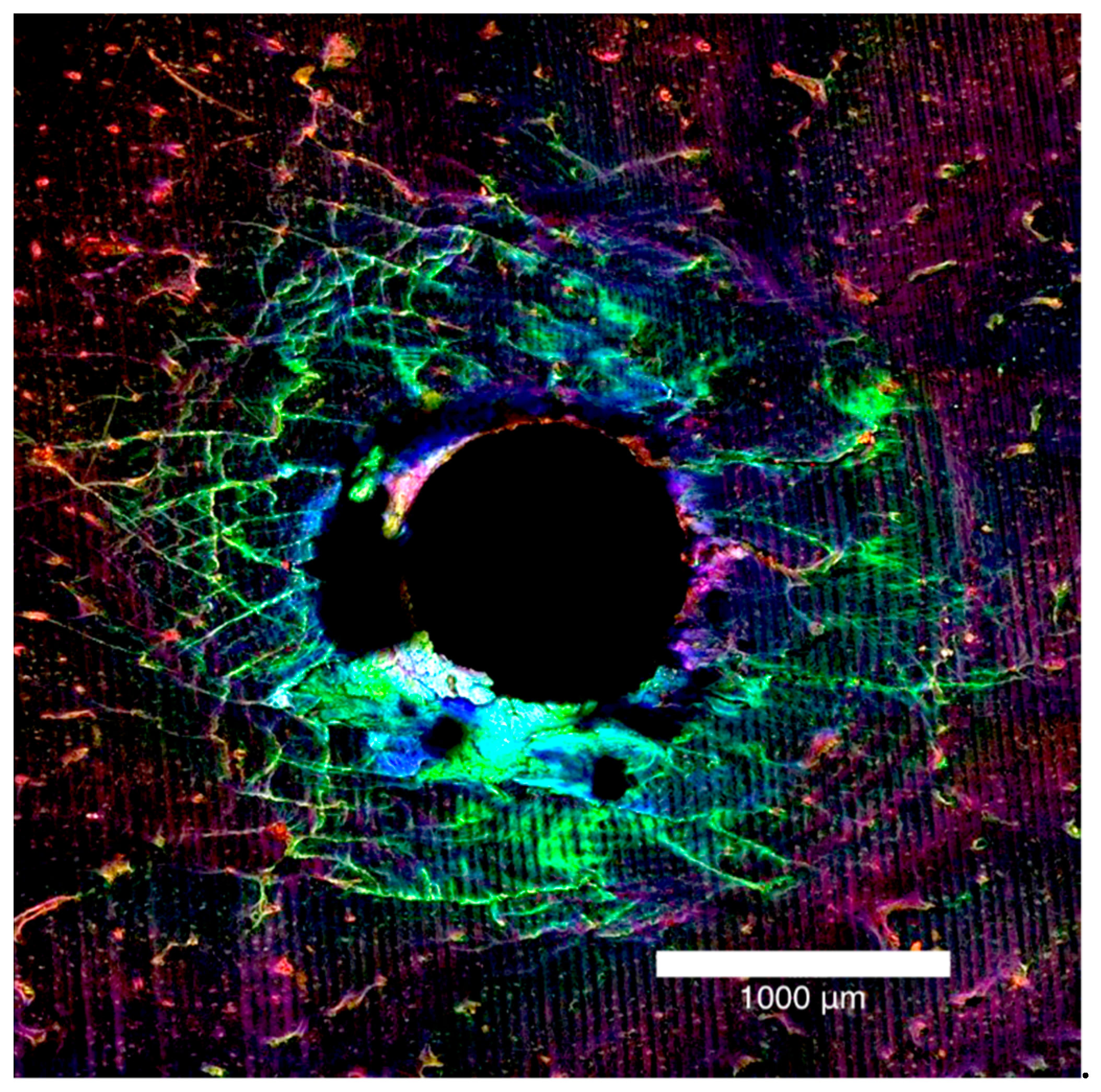Torque Requirements and the Influence of Pilot Holes on Orthodontic Miniscrew Microdamage
Abstract
:1. Introduction
2. Materials and Methods
2.1. Bone Preparation
2.2. Pilot Hole Creation
2.3. First Staining Sequence
2.4. Orthodontic Miniscrew Implant Insertion
2.5. Second Staining Sequence
2.6. Orthodontic Miniscrew Implant Removal
2.7. Third Staining Sequence
2.8. Microscopic Analysis
2.9. Statistical Analyses
3. Results
3.1. Microdamage and Pilot Hole
3.2. Microdamage and Bone Thickness
3.3. Maximum Insertion Torque and Pilot Hole
3.4. Maximum Insertion Torque and Bone Thickness
3.5. Maximum Insertion Torque and Microdamage
4. Discussion
5. Conclusions
Author Contributions
Funding
Institutional Review Board Statement
Informed Consent Statement
Data Availability Statement
Acknowledgments
Conflicts of Interest
References
- Jacobson, A. Mini-implants in Orthodontics: Innovative Anchorage Concepts. Am. J. Orthod. Dentofac. Orthop. 2009, 136, 471–472. [Google Scholar] [CrossRef]
- Kanomi, R. Mini-implant for Orthodontic Anchorage. J. Clin. Orthod. JCO 1997, 31, 763. [Google Scholar]
- Motoyoshi, M.; Hirabayashi, M.; Uemura, M.; Shimizu, N. Recommended Placement Torque When Tightening an Orthodontic Mini-implant. Clin. Oral Implant. Res. 2006, 17, 109–114. [Google Scholar] [CrossRef] [PubMed]
- Motoyoshi, M.; Matsuoka, M.; Shimizu, N. Application of Orthodontic Mini-implants in Adolescents. Int. J. Oral Maxillofac. Surg. 2007, 36, 695–699. [Google Scholar] [CrossRef]
- Suzuki, E.Y.; Suzuki, B. Placement and Removal Torque Values of Orthodontic Miniscrew Implants. Am. J. Orthod. Dentofac. Orthop. 2011, 139, 669–678. [Google Scholar] [CrossRef] [PubMed]
- Wilmes, B.; Drescher, D. Impact of Bone Quality, Implant Type, and Implantation Site Preparation on Insertion Torques of Mini-implants Used for Orthodontic Anchorage. Int. J. Oral and Maxillofac. Surg. 2011, 40, 697–703. [Google Scholar] [CrossRef]
- Wilmes, B.; Rademacher, C.; Olthoff, G.; Drescher, D. Parameters Affecting Primary Stability of Orthodontic Mini-implants. J. Orofac. Orthop. 2006, 67, 162–174. [Google Scholar] [CrossRef] [PubMed]
- Di Lello, F.P.; Sgarbi, F.R.V.S.; Boeck, E.M.; Lunardi, N.; Neto, R.J.B. Effect of Angled Installation of Orthodontic Mini-implants on Primary Stability. J. Res. Dent. 2014, 2, 169–175. [Google Scholar] [CrossRef] [Green Version]
- Shank, S.B.; Beck, F.M.; D’Atri, A.M.; Huja, S.S. Bone Damage Associated with Orthodontic Placement of Miniscrew Implants in an Animal Model. Am. J. Orthod. Dentofac. Orthop. 2012, 141, 412–418. [Google Scholar] [CrossRef]
- Wilmes, B.; Su, Y.-Y.; Drescher, D. Insertion Angle Impact on Primary Stability of Orthodontic Mini-implants. Angle Orthod. 2008, 78, 1065–1070. [Google Scholar] [CrossRef]
- Wilmes, B.; Drescher, D. Impact of Insertion Depth and Predrilling Diameter on Primary Stability of Orthodontic Mini-implants. Angle Orthod. 2009, 79, 609–614. [Google Scholar] [CrossRef]
- Reynders, R.A.M.; Ronchi, L.; Ladu, L.; van Etten-Jamaludin, F.; Bipat, S. Insertion Torque and Success of Orthodontic Mini-implants: A Systematic Review. Am. J. Orthod. Dentofac. Orthop. 2012, 142, 596–614.e5. [Google Scholar] [CrossRef] [PubMed]
- Wawrzinek, C.; Sommer, T.; Fischer-Brandies, H. Microdamage in Cortical Bone Due to the Overtightening of Orthodontic Microscrews. J. Orofac. Orthop. 2008, 69, 121–134. [Google Scholar] [CrossRef]
- Çehreli, S.; Arman-Özçırpıcı, A. Primary Stability and Histomorphometric Bone-implant Contact of Self-drilling and Self-tapping Orthodontic Microimplants. Am. J. Orthod. Dentofac. Orthop. 2012, 141, 187–195. [Google Scholar] [CrossRef] [PubMed]
- Lee, T.C.; Mohsin, S.; Taylor, D.; Parkesh, R.; Gunnlaugsson, T.; O’Brien, F.J.; Giehl, M.; Gowin, W. Detecting Microdamage in Bone. J. Anat. 2003, 203, 161–172. [Google Scholar] [CrossRef] [PubMed]
- Ellis, J.A.; Laskin, D.M. Analysis of Seating and Fracturing Torque of Bicortical Screws. J. Oral Maxillofac. Surg. 1994, 52, 483–486. [Google Scholar] [CrossRef]
- Chen, Y.; Shin, H.-I.; Kyung, H.-M. Biomechanical and Histological Comparison of Self-drilling and Self-tapping Orthodontic Microimplants in Dogs. Am. J. Orthod. Dentofac. Orthop. 2008, 133, 44–50. [Google Scholar] [CrossRef]
- Baumgaertel, S.; Hans, M.G. Buccal Cortical Bone Thickness for Mini-implant Placement. Am. J. Orthod. Dentofac. Orthop. 2009, 136, 230–235. [Google Scholar] [CrossRef] [PubMed]
- Gupta, N.; Kotrashetti, S.; Naik, V. A Comparitive Clinical Study between Self Tapping and Drill Free Screws as a Source of Rigid Orthodontic Anchorage. J. Maxillofac. Oral Surg. 2012, 11, 29–33. [Google Scholar] [CrossRef] [PubMed] [Green Version]
- Nguyen, M.V.; Codrington, J.; Fletcher, L.; Dreyer, C.W.; Sampson, W.J. Influence of Cortical Bone Thickness on Miniscrew Microcrack Formation. Am. J. Orthod. Dentofac. Orthop. 2017, 152, 301–311. [Google Scholar] [CrossRef] [PubMed]
- Jensen, S.W.; Jensen, E.D.; Sampson, W.J.; Dreyer, C.W. Assessment of Microdamage Caused by Orthodontic Miniscrew Pilot Holes. Australas. Orthod. J. 2020, 36, 146. [Google Scholar]
- Martin, R. Fatigue Microdamage as an Essential Element of Bone Mechanics and Biology. Calcif. Tissue Int. 2003, 73, 101–107. [Google Scholar] [CrossRef]
- Yadav, S.; Upadhyay, M.; Liu, S.; Roberts, E.; Neace, W.P.; Nanda, R. Microdamage of the Cortical Bone during Mini-implant Insertion with Self-drilling and Self-tapping Techniques: A Randomized Controlled Trial. Am. J. Orthod. Dentofac. Orthop. 2012, 141, 538–546. [Google Scholar] [CrossRef] [PubMed]
- Katić, V.; Kamenar, E.; Blažević, D.; Špalj, S. Geometrical Design Characteristics of Orthodontic Mini-implants Predicting Maximum Insertion Torque. Korean J. Orthod. 2014, 44, 177–183. [Google Scholar] [CrossRef] [PubMed] [Green Version]
- Son, S.; Motoyoshi, M.; Uchida, Y.; Shimizu, N. Comparative Study of the Primary Stability of Self-drilling and Self-tapping Orthodontic Miniscrews. Am. J. Orthod. Dentofac. Orthop. 2014, 145, 480–485. [Google Scholar] [CrossRef] [PubMed]
- Song, Y.-Y.; Cha, J.-Y.; Hwang, C.-J. Mechanical Characteristics of Various Orthodontic Mini-screws in Relation to Artificial Cortical Bone Thickness. Angle Orthod. 2007, 77, 979–985. [Google Scholar] [CrossRef] [PubMed]
- Buschang, P.H.; Carrillo, R.; Ozenbaugh, B.; Rossouw, P.E. 2008 Survey of AAO Members on Miniscrew Usage. J. Clin. Orthod. JCO 2008, 42, 513. [Google Scholar] [PubMed]
- Nguyen, M.V.; Codrington, J.; Fletcher, L.; Dreyer, C.W.; Sampson, W.J. The Influence of Miniscrew Insertion Torque. Eur. J. Orthod. 2018, 40, 37–44. [Google Scholar] [CrossRef] [PubMed]
- Oltramari, P.V.; Navarro, R.L.; Henriques, J.F.; Capelozza, A.L.; Granjeiro, J.M. Dental and Skeletal Characterization of the BR-1 Minipig. Vet. J. 2007, 173, 399–407. [Google Scholar] [CrossRef] [PubMed]
- Boutrand, J.-P. Biocompatibility and Performance of Medical Devices; Elsevier: Amsterdam, The Netherlands, 2012. [Google Scholar]
- Zimmermann, C.; Thurmüller, P.; Troulis, M.J.; Perrott, D.H.; Rahn, B.; Kaban, L.B. Histology of the Porcine Mandibular Distraction Wound. Int. J. Oral Maxillofac. Surg. 2005, 34, 411–419. [Google Scholar] [CrossRef]




| Characteristic | No Pilot Hole (n = 15) | Pilot Hole (n = 30) | ||
|---|---|---|---|---|
| OMI INSERTION | ||||
| Insertion time (s) | 28.77 ± 2.07 | 17.43 ± 2.80 | ||
| Average insertion force (N) | 22.08 ± 2.25 | 17.02 ± 4.74 | ||
| Max insertion torque (Ncm) | 19.67 ± 3.86 | 21.38 ± 4.19 | ||
| DAMAGE CHARACTERISTICS | Difference | p-value | ||
| Total damage area (mm2) | 4.77 ± 1.80 | 5.60 ± 1.32 | 0.83 | 0.085 |
| Diffuse damage area (mm2) | 3.40 ± 1.26 | 3.34 ± 1.04 | −0.05 | 0.879 |
| Max damage radius (mm) | 1.96 ± 0.49 | 1.82 ± 0.34 | −0.14 | 0.272 |
| Max diffuse damage radius (mm) | 1.32 ± 0.27 | 1.26 ± 0.27 | −0.07 | 0.447 |
| Max crack length (mm) | 1.62 ± 0.46 | 1.34 ± 0.35 | −0.28 | 0.025 * |
| No Pilot Hole | Pilot Hole | |||||
|---|---|---|---|---|---|---|
| Damage Characteristics | 1.5 mm (n = 5) | 2.0 mm (n = 5) | 2.5 mm (n = 5) | 1.5 mm (n = 10) | 2.0 mm (n = 10) | 2.5 mm (n = 10) |
| Total damage area (mm2) | 4.45 ± 1.86 | 4.55 ± 1.76 | 5.30 ± 1.83 | 4.98 ± 1.07 | 5.79 ± 1.12 | 6.03 ± 1.53 |
| Diffuse damage area (mm2) | 3.52 ± 1.50 | 3.24 ± 1.32 | 3.43 ± 1.04 | 2.76 ± 0.75 | 3.54 ± 0.88 | 3.72 ± 1.21 |
| Max damage radius (mm) | 2.12 ± 0.66 | 1.78 ± 0.36 | 1.99 ± 0.39 | 1.66 ± 0.24 | 1.92 ± 0.34 | 1.89 ± 0.36 |
| Max diffuse damage radius (mm) | 1.35 ± 0.39 | 1.33 ± 0.25 | 1.30 ± 0.15 | 1.15 ± 0.31 | 1.28 ± 0.20 | 1.34 ± 0.25 |
| Max crack length (mm) | 1.66 ± 0.62 | 1.49 ± 0.29 | 1.72 ± 0.43 | 1.22 ± 0.26 | 1.43 ± 0.32 | 1.37 ± 0.42 |
Publisher’s Note: MDPI stays neutral with regard to jurisdictional claims in published maps and institutional affiliations. |
© 2021 by the authors. Licensee MDPI, Basel, Switzerland. This article is an open access article distributed under the terms and conditions of the Creative Commons Attribution (CC BY) license (https://creativecommons.org/licenses/by/4.0/).
Share and Cite
Jensen, S.W.; Jensen, E.D.; Sampson, W.; Dreyer, C. Torque Requirements and the Influence of Pilot Holes on Orthodontic Miniscrew Microdamage. Appl. Sci. 2021, 11, 3564. https://doi.org/10.3390/app11083564
Jensen SW, Jensen ED, Sampson W, Dreyer C. Torque Requirements and the Influence of Pilot Holes on Orthodontic Miniscrew Microdamage. Applied Sciences. 2021; 11(8):3564. https://doi.org/10.3390/app11083564
Chicago/Turabian StyleJensen, Sven W., Emilija D. Jensen, Wayne Sampson, and Craig Dreyer. 2021. "Torque Requirements and the Influence of Pilot Holes on Orthodontic Miniscrew Microdamage" Applied Sciences 11, no. 8: 3564. https://doi.org/10.3390/app11083564
APA StyleJensen, S. W., Jensen, E. D., Sampson, W., & Dreyer, C. (2021). Torque Requirements and the Influence of Pilot Holes on Orthodontic Miniscrew Microdamage. Applied Sciences, 11(8), 3564. https://doi.org/10.3390/app11083564






